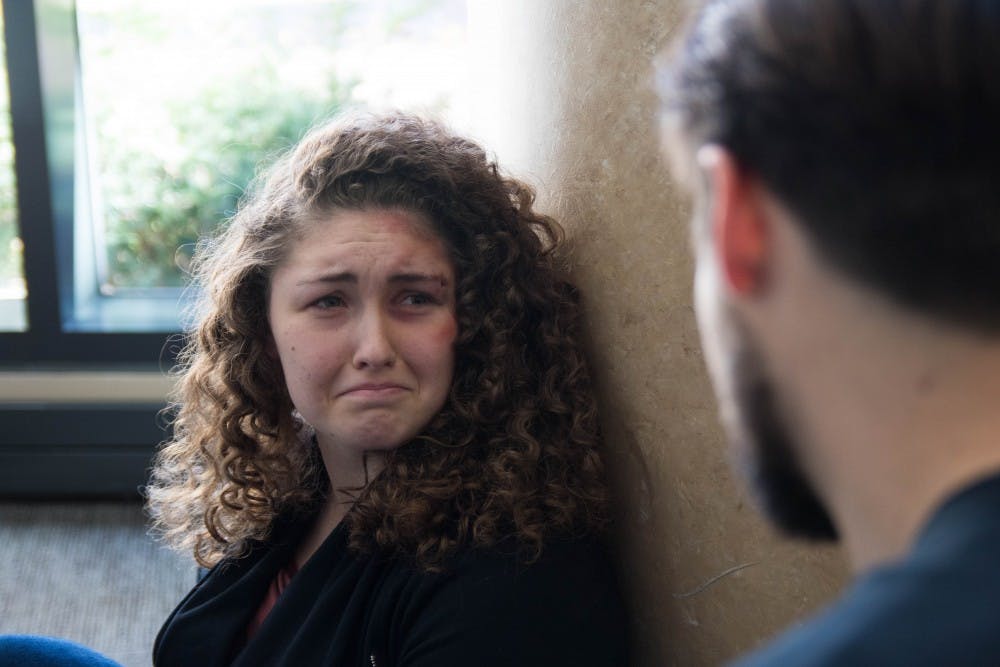Event information:
The event showcased six different living exhibits with eight total actresses and actors.
Next ETA event is April 2 at 7:30 p.m. in the Cave Theatre.
The Ethnic Theatre Alliance brought attention to gender-based violence March 29 through six living exhibits.
ETA hosted Hysteria I as part of Women’s Awareness Month, which is the month of March. The organization focused on both the invisible and visible instances of systematic violence.
Shay Stewart is vice president of ETA and a senior acting major. She said the point of the event is to bring awareness to the many systematic ways women are abused, especially the invisible issues are so common they are not frequently considered.
Stewart used statistics on domestic violence to illustrate her point. 4,000 women each year die in domestic violence related incidents. She stressed how important the spread of information is and how the most change can occur.
“You need to look at how it affects you as a person and branch that idea out into the world,” said Stewart.
Each exhibit highlighted a different form of gender-based violence women experience. Some were more obvious than others, but each facilitated a discussion. Stewart explained the meaning behind each of the six exhibits.
1. Is This Freedom? Featuring Isabel Rivera.
The first exhibit showcased a women bound in bras and make-up. It represents the way ideas of femininity restrict who women are, Stewart said. Culture makes gender expression a requirement, and women are restricted based on ideas of how they are meant to behave and look.
2. Does It Hurt? Featuring Kati Kostyk.
The next exhibit was a woman with a black eye. This was a literal representation of domestic violence, showing the physical aspect of domestic violence. Kostyk also showed the mental effect by being in a catatonic state and looking off in a blank stare.
3. Don’t You Love Me? Featuring Ciara Smith and River Denman.
The third exhibit was the only exhibit with a male actor. River Denman put sticky notes with the word “mine” written on onto Ciara Smith. It showed the ownership men attempt to have over women, Stewart said, not only in personal relationships but also in government legislation.
4. Am I Too Much? Featuring Emma Richman.
The fourth exhibit dealt with women being taught to be small. Not only in a physical aspect, which was shown by a woman trying to put on a dress, but also how women are taught to shrink. This happens in classrooms and board meetings where women have been taught to be silent and not to speak up, Stewart said. This leads to a lack of leadership roles being held by women.
5. Who Am I? Featuring Kathleen Neimann.
The fifth exhibit stresses the issue of women trying to find their own identities. A women struggling with a mask shows the complexity behind a women’s identity. College is meant to be a time of self-exploration, but women are often unable to express themselves. There are a lot of sources telling women who they are supposed to be and a woman in a mask is a representation of that challenge, Stewart said.
6. Can You See Me? Featuring Kelsey Johnson and Rebecca Thompson.
The final exhibit was an examination of the feminist movement’s exclusivity at times in terms of minorities. The exhibit shows a black woman trying to get the attention of a white women and continually being ignored. It specifically shows the issue of minorities not being included into feminist movements, Stewart said.
Kelsey Johnson is a senior acting major and was the focal point of the final exhibit “Can You See Me?” Johnson said to prepare for the role she did research, but she pulled a lot from her own experiences. As an African-American women, many of things she said during the performance came from thoughts she has kept in her mind, Johnson said.
Johnson said the divide among feminist groups is based on fear and a history of separation in the United States. She said society needs an increase in empathy and understanding towards one another.
“We first have to extend love to our brothers and sisters,” Johnson said. “We have to listen better.”
Students who witnessed the exhibit saw it as a fresh way to get the message of gender-based violence across. Karley Sharkey, a sophomore rhetoric major, heard about the event while in the Atrium. She said shewas surprised by what she found when she got to the event.
“I thought it would be flyers and statistics,” Sharkey said.
Sharkey said she has had a lot of friends go through issues like the ones presented in the exhibit in real life. One of the more eye-opening issues for her was people not being able to realize certain relationships being a problem. She said a lot of times problems in relationships start out small and then escalate into being abusive. Sharkey said she has never had these issues presented in this medium and sees potential in it.
“It is going to open eyes,” Sharkey said.
The next ETA event, Hysteria II, is this Sunday at 7:30 p.m. in the Cave Theatre. It will be a storytelling event with a focus on gender norms of both men and women.
All proceeds to the event will go the Young Women’s Christian Association (YWCA.)





